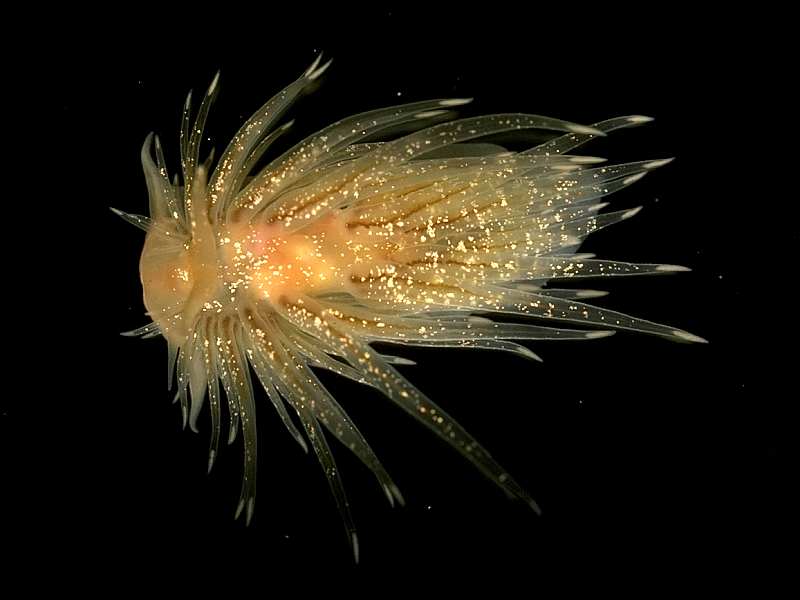Northern Ireland Priority species (NIPS)
| MOLLUSCA : Nudibranchia : Cumanotidae | SNAILS, SLUGS, ETC. |
Cumanotus beaumonti (Eliot, 1906)
 |
| Cumanotus beaumonti |
This beautiful sea slug is rare in Northern Ireland, where it feeds on solitary hydroids.
In brief
- It lives on sandy seabeds or on its prey, the hydroid Corymorpha nutans
- It can only be seen by diving
- This species is rare in Northern Ireland and it has not been found anywhere else in the whole of Ireland. Northern Ireland is also the stronghold for the UK population
- Threats to this species are unknown, as there is little knowledge of the current populations in Britain and Ireland.
Species description: Cumanotus beaumonti has a translucent reddish body and flesh-coloured numerous cerata with pale tips arranged in transverse rows. The back of the body is covered with speckles of gold pigment, and concentrated into patches on the head. The head is broad and bears a pair of finger-like oral tentacles. It is up to 25mm in length, with a broad foot.
Life cycle: As with all nudibranch sea slugs, Cumanotus beaumonti is a hermaphrodite. Spawning occurs in May, with the spawn taking the form of coils of two to four turns of white jelly, attached to the sand by a long, string-like stalk, covered in sand grains.
Similar species: There are no closely similar species, although it could be superficially confused with Facelina bostoniensis. However, Facelina bostoniensis has long oral tentacles, annulate rhinophores and lacks the gold-flecked pigmentation.
How to see this species: This species has only been found off Rathlin Island in 8-15m (16 specimens), south-east of Kilkeel in 20m, and off Cranfield Point, Carlingford Lough in 20m, all in May and June 1985. It can be seen either crawling on a sea-bed of medium sand, or at the tops of and devouring the stalks of the solitary athecate hydroid Corymorpha nutans (Picton, 1991). The animals are vigorous swimmers, moving through the water by repeated violent vertical movements of the cerata or flexing of the body.
Current status: This species has not been seen in Northern Ireland since 1985, when it was found off Rathlin Island, Kilkeel, Cranfield Point and Carlingford Lough. It is only known with certainty elsewhere from Norway, western Scotland and Plymouth.
Why is this species a priority in Northern Ireland?
- The species is rare in Northern Ireland, which holds the only known sites for the island of Ireland, and the majority of the population for the UK, making Northern Ireland both the Irish and UK strongholds for this species.
Threats: Threats to this species are unknown, as there is little knowledge of the current populations in Britain and Ireland.
Distribution Map from NBN: Cumanotus beaumonti at National Biodiversity Network mapping facility, data for UK.
iNaturalist: Cumanotus beaumonti at iNaturalist World Species Observations database.
WoRMS: Cumanotus beaumonti at World Register of Marine Species. Accepted name: Cumanotus beaumonti (Eliot, 1906). AphiaID: 139431.
Classification: Biota; Animalia; Mollusca; Gastropoda; Heterobranchia; Euthyneura; Ringipleura; Nudipleura; Nudibranchia; Cladobranchia; Fionoidea; Cumanotidae; Cumanotus
| Previous species | Next species |
| Authors (2024). Cumanotus beaumonti. (Eliot, 1906). [In] Priority species, Marine Biodiversity Portal NI. https://www2.habitas.org.uk/marbiop-ni/priorityaccounts.php?item=W15200. Accessed on 2025-04-19 |